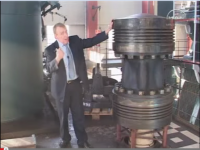I am renting a canal barge on Monday. I do hope it has a Lister diesel. 30 years ago they were highly prised. The canal dates to 1776. The lady said the only blot on the landscap is Rugeley Power Station. Little did she know how much I love power stations. Sizewell B looks like a Mosque.
Two stroke diesels. Wonderful.
Welcome to Rugeley Power Station
Two stroke diesels. Wonderful.
Welcome to Rugeley Power Station
I am renting a canal barge on Monday. I do hope it has a Lister diesel. 30 years ago they were highly prised. The canal dates to 1776. The lady said the only blot on the landscap is Rugeley Power Station. Little did she know how much I love power stations. Sizewell B looks like a Mosque.
Two stroke diesels. Wonderful.
Welcome to Rugeley Power Station
Two stroke diesels. Wonderful.
Welcome to Rugeley Power Station
1932 Biggest Diesel Engine...
Anyway, here's one for ya next voyage.

B&W Double Acting 2 Cycle @ Diesel House, Copenhagen.
My dad was there at a start up a couple of years ago and took a good handful of high quality photos.
IIRC he said that once the engine is running, visitors are allowed to stroll the the walkways and get a close up experience.
This video is especially good, and there are many more videos of this 1932 engine on YouTube.....enjoy.
Dan.
That could be out a Monty Python script......Little did she know how much I love power stations......Two stroke diesels. Wonderful.
Anyway, here's one for ya next voyage.

B&W Double Acting 2 Cycle @ Diesel House, Copenhagen.
My dad was there at a start up a couple of years ago and took a good handful of high quality photos.
IIRC he said that once the engine is running, visitors are allowed to stroll the the walkways and get a close up experience.
This video is especially good, and there are many more videos of this 1932 engine on YouTube.....enjoy.
Dan.
Last edited:
https://www.youtube.com/watch?v=xL2HIuJR43A
YouTube !!! Toothpaste also.
Love that engine. It is like Chaplin film Modern times.
YouTube !!! Toothpaste also.
Love that engine. It is like Chaplin film Modern times.
WD40 - LIST OF 2000+ USES
WD-40_2000_uses.pdf
Dan.
WD-40_2000_uses.pdf
Use a full can for a nifty paperweight
Use can to prop open windows
Cleans and shines magnetic tape
Cleans doggie doo from tennis shoes
Cleans ostrich eggs for craft use
Cleans rust off Santa’s sleigh runners
Eases removal of solidified spitballs
Helps remove rust from pistons of steam engine
Helps remove stuck prosthetic leg
Keeps missile silo doors swinging freely
Keeps stationary bicycle pedals from squeaking
Keeps VCR tapes from sticking in VCR
Loosens strapping tape after a hurricane
Lubricates arm of post-office letter sorter
Lubricates crank motors on antique mechanical phonographs
Lubricates fingers stuck in hole
Removes dog slobber from dash and seats in vehicle
Spray in old radio speaker coil to stop rattling noise
Spray on balcony to keep pigeons away (they hate the smell)
Spray on cable and telephone lines to keep puppies from chewing them
Spray on Twister game for more fun
Dan.
Dan.Contains:
Naphtha (petroleum, hydrodesulfurized heavy);
Distillates (Hydrotreated Heavy Paraffinic);
Non-Hazardous Ingredients;
1,2,4-Trimethyl benzene;
1,3,5-Trimethyl benzene;
Xylene (Mixed Isomers);
and Surfactant.
Considered a Hazardous Substance according to the criteria of the New Zealand Hazardous Substances legislation. Classified as Dangerous Good for transport purposes.
Just back from bashing Narrow-boats in Staffordshire. Izusu 1.5 L 38 BHP 4 cylinder engine. A work of art, hard to think it is Japanese as it looks more like a British design. What a lovely company to deal with for the boat hire and OK on price. A time machine of the best type.
Narrowboat, Barge & Canal Boat Hire - Anglo Welsh Waterway Holidays
Narrowboat, Barge & Canal Boat Hire - Anglo Welsh Waterway Holidays
Dan, my Bluetooth has packed up. However I have a very cheap phone that might have it. See what we can do. SIM will fit. The phone is for a 91 year old friend to receive photos via her friends phones. I don't have bashing photos as that would have made me look even more stupid. If a car the hospitals would have been filled. I only had two bashes. One was a rough looking working barge with no one home, phew. The other one was a very posh guy. He was poshly angry. The thing to say is even if sober the night before counts. Barges are like tapping the head and rubbing the tummy problems. I found driving my car slightly odd afterwards.
1/f noise . Sometimes carbon comp resistors work well and have no obvious noise problems ( eg, PU loading, coil shunts noise ). Foil types can be very good. Doubt this is strictly 1/f, same area of doubt. In phono stages the loading resistor alone seems worth the money. This is understandable. Tyco foil resistors sound as if the stylus is super clean. A double shunt phono stage uses the coil as it's gain setting and no loading except the virtual earth input ( ??? ). They say it sounds very good. I wonder if ideal loading is the question ? Denon DL 110 is 160R, that seems ideal. I dare say low output MC even better .
1/f noise . Sometimes carbon comp resistors work well and have no obvious noise problems ( eg, PU loading, coil shunts noise ). Foil types can be very good. Doubt this is strictly 1/f, same area of doubt. In phono stages the loading resistor alone seems worth the money. This is understandable. Tyco foil resistors sound as if the stylus is super clean. A double shunt phono stage uses the coil as it's gain setting and no loading except the virtual earth input ( ??? ). They say it sounds very good. I wonder if ideal loading is the question ? Denon DL 110 is 160R, that seems ideal. I dare say low output MC even better .
and rubbing the tummy problems.
Good bowel movement.
I took a look at the barge hire link you provided, not cheap but an interesting holiday I'm sure, pity about no photos yet.
The 1/f noise thing is interesting and I need to/must do some in detail experimenting/measurements.
My son is arriving in ten days time and he is about to get a four year apprenticeship in four weeks....including measuring/listening to noise and in particular 1/f noise.
He is into performing/recording/mastering and is about to get a big awakening when he hears my system, and another on the test/repairs bench....that's what dads do !.
"Sometimes carbon comp resistors work well and have no obvious noise problems....."
I expect the key may be in the fine spectrum of the noise (typical FFT measurements are too noisy in themselves) and that more meaningful measurements require very long term averaging to pull out spectral 'flavour' in noise sources.
This may partly explain subjective differences in shunt vs series applications of non noise free resistors.
These links are worth reading -
Stanford Research - About FFT Spectrum Analyzers
Cross-spectrum Analyzer for Low Frequency Noise Analysis
Measurement of 1/f Noise in Carbon Composition and Thick Film Resistors
Using the Carbon Comp Resistor for Magic Mojo
Dan.
The 1/f noise thing is interesting and I need to/must do some in detail experimenting/measurements.
My son is arriving in ten days time and he is about to get a four year apprenticeship in four weeks....including measuring/listening to noise and in particular 1/f noise.
He is into performing/recording/mastering and is about to get a big awakening when he hears my system, and another on the test/repairs bench....that's what dads do !.
"Sometimes carbon comp resistors work well and have no obvious noise problems....."
I expect the key may be in the fine spectrum of the noise (typical FFT measurements are too noisy in themselves) and that more meaningful measurements require very long term averaging to pull out spectral 'flavour' in noise sources.
This may partly explain subjective differences in shunt vs series applications of non noise free resistors.
These links are worth reading -
Stanford Research - About FFT Spectrum Analyzers
Cross-spectrum Analyzer for Low Frequency Noise Analysis
Measurement of 1/f Noise in Carbon Composition and Thick Film Resistors
Using the Carbon Comp Resistor for Magic Mojo
Sweeten the tone ?.....carbon/clay/bakelite shaped dithering perhaps.The manufacturers also document that CC's have excess noise and bad drift with temperature and aging. That makes them a two-edged sword. Put everywhere in an amp, and they'll both sweeten the tone, and at the same time induce hiss. A little thought leads us to the following guidelines for using carbon comps for tone mojo:....
Dan.
What I would say is keep an open mind. In prototype use chip holders and accept a small downgrade until production stage . Choose the input resistor by ear. The CC will not be as good as the foil type I suspect. The metal film possibly the worse of all if a high senstivity stage. CC will sound open yet 1950's in style. As said yesterday if the coil of an MC PU can be the gain resistor I would imagine that can not be beaten. Throughout the design usually I find even the cheapest metal film OK as long as the input resistor is choosen with care. I used to think it was inductance. Now I suspect it is just the combined noise spectrum. If lets say a Lyra Helikon is used of about 7 R total and loaded with 47K CC one would think the resistor to be unimportant as most of the current flows through the coils if DC coupled . In one sense it might be, not the sense you would think. I have used the Helikon with 22R and 47 K and have to say it is not vastly different compared with exspectations. Try CC MF MFoil and the same is not true. CC sweet and a little dull (sepia ). MF , sounds like a dirty stylus. MFoil , open and sweet whilst bright ( like ribbon tweeter ). If 47 K the CC has the lowest noise spectrum ( peaks ) if 7 R shunted by the coil plus PU wires. As would be thought the CC has much more noise unshunted. The foil are $20 a piece ( $8 in bulk direct from Tyco ) , CC 40 cents ( 10 % typical 49 K if 47 K ), MF 2 cents. I like MF 1205 round type SMD as very cheap and very good ( Was Philips, then BC, now Vishay ). Dead bug designs work well with them. The CC drift I think is when worked hard ( 300 V HT and some mA's ).
If measuring an unshunted input the RIAA and Ft of the circuit can be seen when phono in the noise spectrum. Also LF cut. As gain is increased the Ft moves down ( Ft is GBWP/Gain more or less ). When a cheap op amp like MC33078/79 it can still can be 200 kHz Ft when high gain. Use a double inverting stage if wanting the best for the least money. Sometimes the noise problems are sweet spotted so a free lunch can be had if inverting. It is said the gain formula is the reason for the inverting stage advantage. The inverting will come to near zero and the non inverting always to slightly above unity. Clicks may be exagerated due to the A/B+ 1 as compared with -A/B. To be honest the input resistor will be more important when the MC33078 or better is used in sound terms if high gain, this is not trivial and can save money. High gain usually sounds good as it still it very much better than 1947 hi fi standards of 0.1% THD. Also the chip will be highly stable at high gain. In fact if clipping can be avoided to pot down for MM would not be stupid if researched with care. I usually find op amps sound best at gain 1 or > gain 10. If a, RIAA was gain 10 and 10 MM with gain 1000 for some MC that might be ideal. In fact to switch to 62/ 17 as I do seems about right. For DL 110 17 / 17 ( circa 150 at LF ) would seem very good. 10/10 Shure M44 10/17 MM 17/17 DL110 62/17 Lyra and Ortofon MC25. The Lyra was tried at gain 550, I prefer higher gain. I did use 120/17 for a SPU. It was very OK and maybe better than cheaper transformers. Hiss was about Revox at 0 VU. If using non inverting try a 2 uS passive output filter. I use 220 R and 10 nF, the 220R is also the loop braker that often is needed. It can be 47R and 47 nF or whatever. Try it all ways as sometimes it is a step too far ( no idea why ). Piano will often say.
If measuring an unshunted input the RIAA and Ft of the circuit can be seen when phono in the noise spectrum. Also LF cut. As gain is increased the Ft moves down ( Ft is GBWP/Gain more or less ). When a cheap op amp like MC33078/79 it can still can be 200 kHz Ft when high gain. Use a double inverting stage if wanting the best for the least money. Sometimes the noise problems are sweet spotted so a free lunch can be had if inverting. It is said the gain formula is the reason for the inverting stage advantage. The inverting will come to near zero and the non inverting always to slightly above unity. Clicks may be exagerated due to the A/B+ 1 as compared with -A/B. To be honest the input resistor will be more important when the MC33078 or better is used in sound terms if high gain, this is not trivial and can save money. High gain usually sounds good as it still it very much better than 1947 hi fi standards of 0.1% THD. Also the chip will be highly stable at high gain. In fact if clipping can be avoided to pot down for MM would not be stupid if researched with care. I usually find op amps sound best at gain 1 or > gain 10. If a, RIAA was gain 10 and 10 MM with gain 1000 for some MC that might be ideal. In fact to switch to 62/ 17 as I do seems about right. For DL 110 17 / 17 ( circa 150 at LF ) would seem very good. 10/10 Shure M44 10/17 MM 17/17 DL110 62/17 Lyra and Ortofon MC25. The Lyra was tried at gain 550, I prefer higher gain. I did use 120/17 for a SPU. It was very OK and maybe better than cheaper transformers. Hiss was about Revox at 0 VU. If using non inverting try a 2 uS passive output filter. I use 220 R and 10 nF, the 220R is also the loop braker that often is needed. It can be 47R and 47 nF or whatever. Try it all ways as sometimes it is a step too far ( no idea why ). Piano will often say.
- Status
- Not open for further replies.
- Home
- Member Areas
- The Lounge
- Sound Quality Vs. Measurements

